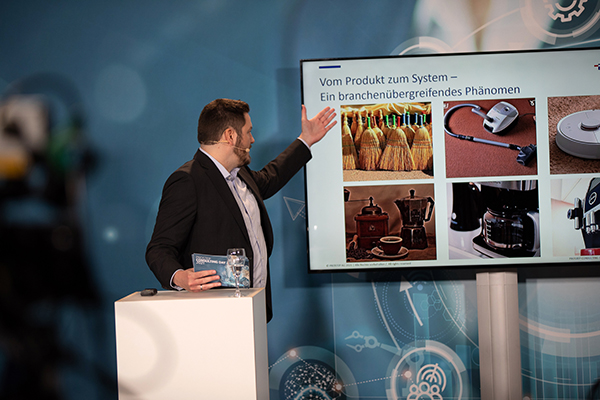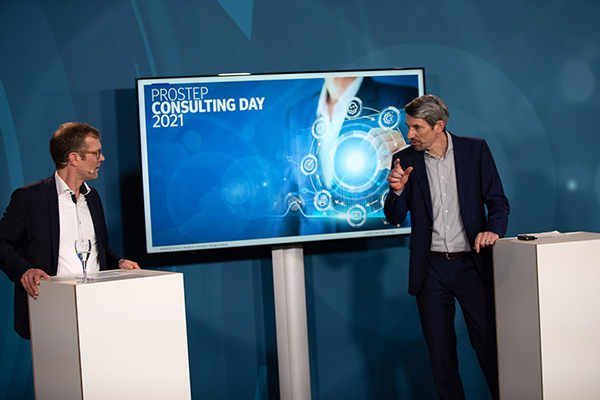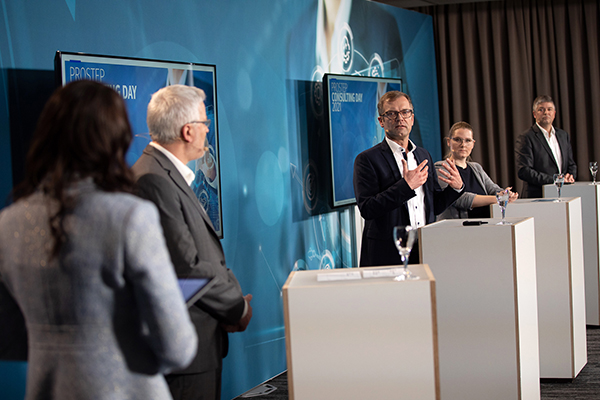
|
What PLM strategy looks like in a VUCA worldBy Joachim Christ What does PLM strategy look like in a world characterized by volatility, uncertainty, complexity and ambiguity (VUCA)? This was the key question addressed at the first PROSTEP CONSULTING DAY. In three live sessions, those participating learned how our capability-based PLM strategy consulting helps them master the challenges posed by digitalization. 
It was the first time that we had organized the PROSTEP CONSULTING DAY. The coronavirus pandemic meant that the premiere had to take place online. We consider the high level of participation confirmation of our concept. The participants attended three sessions with different topics that were held at different times and professionally moderated by Julia Bauer. A quick online survey indicated that approximately 35 percent of those attending were from the automotive industry, followed by 16 percent from the mechanical and plant engineering industry. In the first session, Dr. Martin Strietzel, head of Strategy and Processes, discussed together with colleagues the topics of the future that are of interest to the manufacturing industry and the challenges that digitalization poses to companies. The hype surrounding digitalization stems the fact that we now have at our disposal the technical capabilities required to utilize it in engineering, in the context of Industry 4.0 and for service purposes. However, an effective digitalization strategy is needed to respond to unforeseen events in an appropriate manner, said Strietzel. "The best answer to VUCA is VUCA, in other words vision, understanding, clarity and agility." 
PROSTEP believes that the digital product lifecycle, with focus on the digital twin, is a key element for getting to grips with the challenges posed in these times of VUCA. One of these challenges, especially for midsized companies, is the internationalization of development and production, said lead expert Peter Wittkop. Without a digital thread, there will always be incompatibilities due to the fact that the changes made to products and tools locally are not communicated systematically. This is why configuration management is becoming increasingly important. "In this context, configuration management refers to the traceability of product information, both horizontally throughout the product lifecycle and also vertically in terms of analyzing the impact that changes have on other domains." Companies are not only wrestling with internationalization but also with the transition from what was once a mechanical product to software-based systems, which entails further challenges such as interdisciplinary collaboration or digital validation and verification. Traceability is a key capability that makes it possible to start testing against product requirements early, said senior consultant Christian Buehler. Complexity as a driver of digitalization Increasing product complexity is a major driver of digitalization, as the customer presentation by Theegarten-Pactec made clear. The packaging machines for confectionery that the midsized company manufactures have, over the course of the past few decades, developed into complex mechatronic systems with a high proportion of electronics and software. The company is tackling topics like requirements management, systems engineering, agile software development and traceability to ensure that it can maintain its productivity and flexibility in the face of increasing complexity. PROSTEP is helping Theegarten-Pactec improve interaction between IT systems and processes and find an appropriate development plan for the application landscape. Not only security but also PLM and ALM (application lifecycle management), the digital twin and digital continuity are the topics that are currently of greatest importance to companies. Digital business models are a key driver for the implementation of digital twin concepts, as senior consultant Dr. Lars Wagner explained using a number of different examples. 
Digitalization also presents the IT organizations in the companies with new challenges. They have to provide the best possible support for the development of smart, connected products and interaction between disciplines by means of a shared development space, as senior consultant Marc Dreesen pointed out. To do this, the role played by IT in companies needs to be expanded. It must be seen as a proactive innovator that provides new solution concepts rather than merely a reactive service provider. Customers' specific needs, product features and business models are increasingly software-driven, as Dr. Steven Vettermann, Manager PLM VV, said during the second CONSULTING DAY session. "Therefore, if you want to be a winner, you need to master the creation of value with software." The key achieving this is the combination of MBSE and ALM. PROSTEP is familiar with the strengths of the individual solutions and provides customers with support during strategic realignment and the introduction of new tools for ensuring traceability. Concepts for end-to-end digitalization In the second session, we presented solutions and concepts that help customers get to grips with end-to-end digitalization. PLM is not an entirely new technology, but it is the key to end-to-end digitalization and provides the basis for the digital twin, said principal consultant Dr. Mario Leber. An important aspect of the PLM concept is managing the different types of BOMs. In addition, cross-domain issues such as project and change management also need to be taken into account. And there are hot topics such as requirements management, which according to the survey is an important part of their PLM concepts for three quarters of the participants, as well as the topic validation and verification. The challenge when it comes to requirements management is ensuring end-to-end digitalization both vertically between customer requirements and technical requirements as well as horizontally between the requirements of the individual disciplines, as the presentation by consultant Veronica Haber made clear. Her colleague, Kim Steinkirchner, explained the different steps involved in verification and validation from component through to system level. Relationships can only be identified if the relevant data sets are linked together consistently. That is the main purpose of PLM. 
"The cloud, low-code, ALM – just how disruptive is PLM?" This is this question that Martin Strietzel attempted to answer. The biggest disruption is caused by PLM itself, he said, because the product lifecycle now encompasses a number of new topics, such as the Internet of Things for example, which plays an important role in the context of connecting service and feeding back information gathered in the field. But is that still PLM? Many PLM vendors have recognized the importance of IoT and have acquired companies or developed their own IoT platforms, said Strietzel. The increasingly dynamic nature of the market is due to the fact that the IoT market, for example, is ten times the size of the PLM market. When it comes to SaaS or multi-tenant applications, the cloud is still underrepresented in PLM environments. This is gradually changing because companies' confidence in terms of security has grown, said senior consultant Marc Dreesen. At the same time users have become more willing to adhere more closely to standards, while vendors have improved the adaptability and integration capabilities of cloud applications thanks to low-code and integration-as-a-service offerings. Almost everyone now has a cloud strategy, but their offerings are sometimes difficult to compare, which is why PROSTEP has created a corresponding checklist. Capability-based procedural model In addition to the ability of companies to change, also with regard to new business models, the future viability of their PLM architectures will be a major challenge in the coming years, said Peter Wittkop at the start of the third CONSULTING DAY session. The strategic combination of a methodological approach and PROSTEP's wide-ranging PLM-specific know-how will be helpful when it comes to mastering these challenges together. Capability-based strategy development is used to achieve medium and long-term objectives, but it must also be able to respond in an agile manner when the objectives change. Martin Strietzel and consultant Manuel Ratte explained to participants what PROSTEP's capability-based procedural model looks like and how it relates to corporate strategy. In the context of enterprise architecture management, PROSTEP understands the PLM architecture to be a multi-layer model that examines processes, data integration and the applications based on a company's objectives. The consultants use the construct 'PLM capabilities', which maps all the PLM-specific topics relevant to the product lifecycle, to make it easier to address the requirements on the three levels. The participant survey indicated that the PLM capabilities that pose a particular challenge to companies are requirements management, product structure management, configuration management and change management. The capability-based procedural model is one of the core elements of PROSTEP's consulting approach. As Manuel Ratte explained, the consultants define the actual and target statuses based on the PLM capabilities and in combination with the maturity model. They provide the basis for developing overall concepts regarding the required PLM capabilities, which are then merged to create a target architecture. Based on this vendor-neutral architecture, the consultants evaluate the potential systems and recommend the suitable solutions to the customers. During roll-out planning, they then determine together with the customers how the transition to the new world should be implemented. Clear documentation of the requirements Using a number of different examples, Mario Leber explained the work results and the concrete benefits that a capabilities-based consulting approach offers. Of particular value to customers is, on the one hand, the digital maturity analysis, an efficient methodology for classifying the individual subprojects and defining the digital roadmap. It is based on an assessment of the actual and target scenarios or a gap analysis of the PLM capabilities. On the other hand, customers could use PROSTEP's requirements specification template to document and communicate all their requirements efficiently, individually and transparently. One customer that has taken advantage of PROSTEP's capability-based PLM strategy consulting services within the framework of a comprehensive PLM and SLM (systems lifecycle management) initiative is thyssenkrupp Presta AG. In an interview, project manager Klaus Brandner explained the project's objectives and the challenges it poses and how PROSTEP is helping the company tackle them. The external consultants were particularly important during the orientation phase, when the diverse requirements of the departments involved needed to be harmonized. Their support, he said, made it possible to get to grips with this demanding task. "The most important contribution that PROSTEP made was to put an end to the stakeholders' anxiety regarding the new topics." PROSTEP not only provides customers with advice when defining their PLM strategy, but also helps them with implementation. At the end of CONSULTING DAY, Peter Wittkop explained the further course of action to the participants. The aim is to implement the project objectives step by step to quickly achieve partial successes and exploit the benefits. This is why PROSTEP believes that an agile approach has proven its worth. Personal relationships and mutual trust provide the basis for collaboration in consulting projects. If you would like to learn more about the challenges posed by digitalization and PROSTEP's capability-based consulting approach, you will find the videos of the three sessions here. (Please note, the videos are only available in German.) 
|
|
| © PROSTEP AG | ALL RIGHTS RESERVED | IMPRINT | PRIVACY STATEMENT | YOU CAN UNSUBSCRIBE TO THE NEWSLETTER HERE. |

